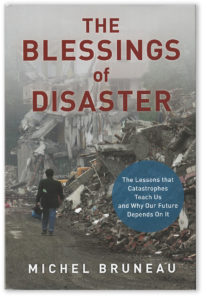Facility management can be an ugly business. Aside from the challenges of customer satisfaction, a facility manager must understand and manage risks of many different types. The bad news is that many APPA members have learned how to manage disasters the hard way. The good news is that they’re usually happy to share their learning experiences with others. This book identifies some additional learning experiences, theories, and cautions for anyone who is responsible for the planning, design, construction, or operation of a facility.
The Blessings of Disaster
Bruneau, Michel, Prometheus Books, Essex, CT, 2022, 350 pages, hardcover, $30.
 Facilities consist of buildings, roads, bridges, treatment plants, hospitals, and manufacturing facilities. All are managed and operated by facility managers, who often have limited resources or the ability to predict the future to avoid natural and anthropomorphic hazards and threats. Facility managers must be aware of many risks. It’s helpful to know all the risks in advance, but prior knowledge is not always available or believed.
Facilities consist of buildings, roads, bridges, treatment plants, hospitals, and manufacturing facilities. All are managed and operated by facility managers, who often have limited resources or the ability to predict the future to avoid natural and anthropomorphic hazards and threats. Facility managers must be aware of many risks. It’s helpful to know all the risks in advance, but prior knowledge is not always available or believed.
The challenge for many people to prepare is that disasters are infrequent and often far away. Michel Bruneau, a professor of structural engineering at the University at Buffalo, leads one of the largest earthquake test facilities in the United States. In The Blessings of Disaster, he presents several different sources of disaster and cautions about ignoring their frequency. While focusing on earthquakes and other disaster events, floods, windstorms, and volcanoes, he mentions climate change as an anthropomorphic hazard but omits arson and vandalism. Of course, preparing for multiple potential disasters is difficult, if not impossible. The difficulty of predicting that an event will occur at a given time or location, in order to support protective expenditures, makes many budget-watchers dubious. Although some states have legislated building code changes (such as California for earthquakes and Florida for hurricanes), many others have ignored the hazards because “they don’t happen here” or “it’s not likely to happen.” Moreover, facility owners, daunted by the cost of protection, frequently assume that insurance will make disaster recovery manageable from a financial perspective and thus resign themselves to the interruptions associated with disaster recovery.
Throughout the lengthy text, Bruneau uses a readable style to cite disasters that have occurred through the years. In both his preface and opening chapters, he recommends skipping material if it’s not of interest or applicable. However, in the later chapters, he explains how skipping information about disasters can be a problem. Just because a recent disaster didn’t occur nearby doesn’t mean it won’t happen to you at a future date. Those darn statistics on disasters. Disasters are random, but some are less random than others.
For example, some older APPA members may remember the 1993 rains in the northern and western United States that resulted in severe flooding in St. Louis, where APPA was meeting for its annual conference. The conference continued, but many popular tourist spots near the river were underwater. In 2000, in turn, APPA held a conference in Fort Worth, Texas (as it will again in June of 2024) following a tornado; the hotel atrium skylights were temporarily covered with plywood due to the storm damage. In both cases, “the show must go on” mentality prevailed, and the show did go on, but there are certainly times when it must be delayed.
Some of our campuses have experienced similar events, along with hurricanes, volcanic eruptions, earthquakes, power outages due to ice storms, and terrorist events. The show goes on through the creativity and grit of facility managers and workers. The Blessings of Disaster demonstrates the need for preparation in one form or another. While omitting FEMA training, the author presents succinct examples of how preparation—beginning at the facility design stage—can help avoid disaster-driven interruptions.
The Blessings of Disaster is not like the disaster movies of the 1970s, such as Towering Inferno and Poseidon Adventure, although Bruneau does reference disaster and horror films in one chapter. He describes potential disasters, identifies their probabilities, and makes good arguments for exercising prudence to protect facilities from their effects. He provides very few numbers (if you don’t like them) while still dispensing quality technical information. It’s a good read for a cold winter night—or perhaps a beach vacation.
APPA Fellow Theodore (Ted) Weidner, PhD, PE, RA, NCARB, DBIA, CEFP, is professor of engineering practice at Purdue University, West Lafayette, Indiana, and consults on facilities management issues primarily for educational organizations. He can be reached at [email protected]. If you would like to write a book review, please contact Ted directly.
Bookshelf
Book reviews on current publications relevant to the profession, trends, and working environment of facilities and educational managers and professionals. To contribute a book review, contact Ted Weidner, field editor of this column.
See all Bookshelves.


